SITREP 3/7/24: Macron Raises Rhetoric Temp, First HIMARS Kill, Black Sea Fleet Setbacks & More
Things are in a slight lull at the moment as Russian troops on the previous active fronts are said to be taking a brief tactical pause to regroup and consolidate gains. In the meantime, let’s take a moment to catch up on some interesting article roundups, which continue to fill in the gaps of our ongoing understanding.
The first is a Washington Post article which reveals some interesting things:
I know the Avdeevka retreat’s been beaten half to death, and I’m just as over it as you probably are. But here’s a couple things worth noting, that will tie together into a larger whole. They first focus on a 21 year old AFU soldier who just ‘barely’ made it out from the Russian advance:
By the time his unit retreated, he was in charge. So many soldiers had been wounded that there was “nobody more senior left,” the 21-year-old said.
When his group finally left the city entirely, he watched the convoy in front of him erupt into fire as artillery took them out. “It was just a convoy of people. A convoy of the best men ever. And in front of our eyes, this convoy was destroyed by artillery. People of my age, between 20 and 30.”
I post this specifically because pro-UA supporters continue to push the narrative that Russia took more losses in Avdeevka. But first hand reports from their own troops indicate otherwise. In light of the above, a new archival video of the big retreat was released today showing very well one of the turkey shoots the soldier above may have witnessed:
Geolocated to near Lastochkino:
“This was the road of death,” he said, “the very last one out of Avdiivka.”
The next profiled soldier makes an interesting claim:
Around three-quarters of the Russians they fought appeared to have decent military training, he said. The rest were “just confused.” But only a little more than half of his troops had any combat experience themselves.
It does put things in perspective: so many pro-UA’ers claim Russian troops are so inadequate yet forget their own are way worse at this point. This matches a new writeup from freelance CNN correspondent Matyas Zrno, who stated the following about the current situation—read the bolded part:
"So: the situation is bad. Artillery ammunition is really in short supply. There are few people. Many positions on the front are filled only symbolically. No other line exists and is not being built (or only sporadically). Ukrainians are to die for in this - unsystematic.
Soldiers complained in the same way last year when Bachmut fell that nothing was being built. The soldier simply retreats, digs a hole, and over time connects it with the hole of the soldier next to it and thus builds a defensive line.
Russian strategy is effective. They break through the defenses with artillery bombardment and glide bombs (those are truly terrifying), then wear down the defenders with human waves of "disposable soldiers", and only then do the well-trained and equipped soldiers move in. The Russians also have the upper hand in drones.
They simply succeeded in the transition to war production (with Chinese help). We often hear: "We might come up with something, the Russians will copy it and produce it in much larger numbers". But here is the light at the end of the tunnel in Ukraine's take-off production. Mobilization is a big topic. Quite logically, the soldiers get annoyed when they see young men in the city enjoying a normal life while deserting. "If we had mobilized two years ago, we now have an army ready," said one officer. The dilemmas of how to ensure the defense of the country so that it is effective, the economy does not collapse and it does not financially ruin the country are understandably not of much interest to the soldiers.
Everyone wants to send policemen to the front (there are half a million policemen in the country and no one understands why, for example, six policemen with submachine guns must be patrolling the center of Uzhhorod at once) and especially customs officers. I understand them...
Zaluzny's replacement upset some, some didn't, but apparently it didn't make any big waves in the military. The soldiers would prefer to replace half of the commanders. The quality of command is very variable, to put it politely. It's probably no secret that where there are good commanders who take care of their men, morale is high. This is often not the case.
The big blow was the fall of Avdijivka, or rather, how she fell. The late retreat apparently resulted in heavy unnecessary losses. Ukrainians don't waste people like Russians, but believe me - some commanders aren't afraid of it either...
When the First World War broke out, Lord Kitchener told the British Cabinet that it would take two years to build the army needed for that war. They looked at him like a puck. He was right... The war will now last for years and Ukraine should prepare a "new" army like Kitchener once did.
And one more (British) history lesson. In 1915, a shortage of artillery ammunition (yes, it was all already there...) led to a reform of the government and the creation of a new ministry for munitions production. Just a total war is a total war and requires total mobilization of society in Ukraine (which has not happened yet) and maximum support from us (which has not happened yet, although in truth it could have been worse...)
Ukraine should build a strong defense and train a "new" army and, together with Europe (which should stick its head out of its "ESG" ecologically-sustainable, socially-responsible ass), start war production corresponding to the intensity of the war."
The above is corroborated by another recent piece:
NYT about the problem of Russian aerial bombs with UMPK. Planning bombs destroyed any AFU fortifications in Avdiivka and contributed to the rapid advance of the Russian Army in urban development. "These bombs completely destroy any position," Yegor Sugar, a Ukrainian soldier, said on social media. All buildings turn into pits after strikes by the Russian aerospace forces.
Recall what I’ve written in previous reports about that very tactic: Russia softens them up with massive bombardment, then sends in units like Storm-Z penal troops or DPR volunteers. Only at the very end when the breakthrough is open, Russia pours in elite forces and more of nominal Russian army regulars.
Famed correspondent Andrei Filatov who worked the Avdeevka frontline from the very beginning recently said that the final take over of the Dachas area in particular came at “very minimal losses” to Russia. This was eye-opening for the fact that Filatov has become known for heavily criticizing unneeded Russian losses, bad Russian generals and tactics, etc. Thus for him to say the final rout came with minor losses is very meaningful and almost certainly true, as he would have no issues whatsoever admitting to large losses as he did in the opening stanza of the Avdeevka campaign.
Next comes another WaPo piece, if only for one potentially jaw-dropping revelation it offers:
In essence it details how Zelensky and his leadership have continued to fail in coming up with a full-on mobilization plan despite warnings of severe troop shortages on the front:
Zelensky’s inability to forge a political consensus on a mobilization strategy — despite months of warnings about a severe shortage of qualified troops on the front — has fueled deep divisions in Ukraine’s parliament and more broadly in Ukrainian society. It has left the military relying on a hodgepodge of recruiting efforts and sown panic among fighting-age men, some of whom have gone into hiding, worried that they will be drafted into an ill-equipped army and sent to certain death given that aid for Ukraine remains stalled in Washington.
This accords with another new article:
But the big bombshell from the WaPo article that’s got everyone buzzing is the following:
Yes, the article seems to imply that 700,000 Ukrainian soldiers have simply vanished or are missing—at least that’s what the pro-Russian commentariat is extracting from it.
And it’s true, recently Ukrainian officials have continued to claim that there are upwards of 700k to 1 million Ukrainians in the armed forces, but have also specified that about 250-300k or less are ‘on the actual frontlines’. This is precisely the number I gave long ago, for those who may recall, by way of my own calculations of different combat zones cross-checked with the Pentagon leaks from early 2023.
But allow me to say that I don’t think it necessarily means 700k are missing or dead as most are implying, though it could be. You see, in any army the ratio of bayonet strength to noncombat forces is generally in that 3:1 or more range—U.S. army for instance being even more. That means it would technically make sense for Ukraine to have 200-300k frontline capable combat troops, with the remaining 700k+ in the rear as part of logistics units or reserves undergoing further training, as well as border guards, etc.
However, the WaPo article clearly seems to suggest that no one even amongst Ukrainian officials knows where those 700k are, which would imply something more sinister.
After all, suppose they had those 700k in the rear—wouldn’t those be much easier to train into combat troops and send to the front, since the already have military experience? Why, then, the mad scramble and desperation for fresh meat off the streets? Recall, Ukraine previously admitted requiring 20-30k monthly mobilizations just to break even—presumably with losses.
So: was the WaPo slipup a look behind the curtain to Ukraine’s true losses? I’ll let you decide, but it certainly seems to suggest something very fishy going on with their numbers such that even top mainstream outlets like WaPo are now openly questioning Zelensky’s official figures. In the best case scenario, it may be lies meant to conceal the true severity of Ukraine’s current troop and mobilization problem; and in the worst case, it may be a revealing clue as to Ukraine’s total losses.
Incidentally, even Marco Rubio has now admitted that his previous overly positive assessments were in fact lies meant to buoy Ukraine’s morale, when in reality he now sees no victory possible:
—
Let’s move into the next most exigent matter.
Europe’s continued escalatory rhetoric remains concerning. After the German general staff were exposed in last week’s Taurus scandal, parties have increasingly begun laying their cards on the table.
Macron has come out with several new belligerently foreboding statements which seem to suggest my theory about France’s humiliation and consequent revenge-seeking may be accurate:
Though there are other concomitant reasons. For instance, France is somewhere in the top 5 of world’s top agriculture export countries, and wants to protect that status. Their foreign minister recently shared his trepidation at what would happen if Russia took over all Ukraine:
Moscow’s victory in Ukraine will result in major financial losses for Europe; from an economic point of view, the situation will become catastrophic - French Foreign Minister Séjourné.
In this case, according to the minister, in the field of agriculture, Russia will then be able to take control of more than 30% of the world wheat market.
The West needs to achieve the defeat of Russia without starting a conflict with it - "we are not talking about the war in Ukraine," the official added.
This was followed by Czech president Petr Pavel stating that sending NATO troops to Ukraine should be an option that is ‘explored’.
This happens to be concurrent with several things. Firstly, Sweden was officially inducted into NATO today. Meanwhile, the European Steadfast Defender and Dragon 24 exercises in Poland were said to practice the crossing of the Vistula River right near Kaliningrad:
⚡️ Footage of the crossing of the Vistula by NATO troops as part of the Stalwart Defender 24 exercise in Poland.
The three-day event reportedly saw 3,500 troops and hundreds of pieces of equipment ferried across the river.
Crossing has traditionally been a major focus for NATO ground forces, but there is no indication whether this component includes countering an air or missile attack that could make a crossing impossible.
Though the quality of the training is open to question:
A Polish soldier seriously injured during a training exercise has died, raising the death toll to two, military authorities said Wednesday.
A military tracked vehicle ran over two soldiers, killing one and injuring the other during a drill at a test range in Drawsko Pomorskie, in northwestern Poland, on Tuesday. The injured soldier was airlifted to a hospital.
It spurred Russia’s Patrushev to remark that NATO is definitely rehearsing for the inevitable:
But if that wasn’t enough, at the same time the Nordic Response exercises are being held just miles from the Russian border in the north:
Nordic Response in detail:
Contents of the exercise program:
- landing operations (sea);
- Air Force exercises;
- spontaneous training of paramedics and much more.
Units that will act as instructors when performing tasks:- SAS;
- SEAL;
- UTJR;
- Green Berets.According to the specifics of the units, we see it as logical for them to participate in the following elements:
1) Instructors from SAS and SEAL will conduct classes on amphibious landing of units, capturing defense lines and destroying important objects of the alleged enemy in coastal territory. Green beret, represented by groups of instructors from the 10th Parachute Regiment of the Special Forces, will practice assault, offensive and defensive operations on land.
Thus, the cycle is consolidated - landing, occupying the first line of defense, moving deeper.
2) A group from UTJR Finland will conduct classes within the specifics of the tasks performed in a harsh climate.
From which it follows that the classes will be aimed at practicing tactics in difficult climatic conditions, working in mountainous and wooded areas, and engineering training in forests and mountains.
It is worth noting that the exercises are conducted in Scandinavian climatic conditions, where many fighters will encounter difficulties for the first time.
According to open sources, not only northern countries are participating in these exercises, but there are also representatives of Spain, France, Italy, for them such a change in the geography of tasks, although within the framework of training, is a fundamentally new experience.
The rangers' knowledge is being exchanged with other NATO special forces units. This is a good practice in terms of the possibility of improving the skills and capabilities of the unit’s units.
Let us note that representatives from the Armed Forces of Ukraine and the Security Service of Ukraine are not involved at all in the NATO exercises.
What is this connected with?
- Personnel shortage of specialists in the ranks of the Armed Forces of Ukraine.
- Ukraine cannot ensure its own participation in the exercises.
- There is a war in Ukraine, they are not distracted, but they are using it as a testing ground.
And while all this is going on, Germany and Russia both are apparently planning to test their national nuclear alert systems:
🇷🇺🚨 On March 6, the public warning system will be checked throughout Russia
The Ministry of Emergency Situations urged not to be afraid of the sirens that sound during the day in Russian cities.
🔹They, like signals on television, radio, and loudspeakers, will be part of a general global check.🔹
Did I mention that Germany’s Pistorius is now reportedly fast-tracking the reintroduction of compulsory service, i.e. mandatory conscription, in order to speed up NATO’s looming war against Russia?

That only follows suit after Latvia already introduced the measure last month:
Not to be left out, Lukashenko signed a new decree simplifying measures to move Belarus into full wartime operations if and when necessary:
Belarusian President Alexander Lukashenko has signed a decree to bring all government agencies into "wartime operational conditions."
Lastly, on the developing Moldovan front, escalations likewise continue:
Military expert Alexander Zimovsky: "Moldova has indefinitely withdrawn from the Treaty on Conventional Arms in Europe (CFE Treaty). This opened the way for the free entry of NATO forces into the territory of Moldova in any numbers." So what did you think? NATO intends to destroy Russia, as they stated earlier. Have you heard them abandon this idea? And I didn't hear it either.
Which is why Putin has now met with the Gaugazian rep. to hear her security requests:
Vladimir Putin, the President of the Russian Federation, met with Evghenia Guțul, the highest representative of the Gagauz people (the Governor of Gagauzia) and a politician from Moldova, in the city of Sochi on Tuesday.
I informed him about the illegal actions of the authorities in Moldova, which take revenge on us for our civil status and loyalty to national interests,
Step by step, Chisinau takes away our powers, cuts the budget, violates legal rights and causes instability and destabilization in Gagauzia and across the country.


The public meeting was a clear message sent by Putin that he will be taking up the Gaugazia and Pridnestrovie issues as a counterbalance to increased NATO provocations.
I suppose it bears reminder that Polish general Jaroslav Kraszewski recently stated Poland’s intentions, or at least wishes, of obtaining nukes for ‘security reasons’:
Polish general, former head of the department for supervision of the armed forces in the National Security Bureau, Jaroslav Kraszewski, stated this on RMF FM.
He called such a scenario “very realistic.”
When asked about the cost of maintaining such weapons, the general replied that “security has no price.” And he called on the Polish authorities to seriously address this issue in the coming years, because “usually countries with nuclear potential are not attacked.”
The concept of Nuclear sharing implies that NATO member countries that do not have their own nuclear weapons can participate in planning the use of the Alliance’s nuclear weapons, as well as transport and store them on their territory.
Poland may obtain nuclear weapons in a few years This was stated by Polish General Jarosław Kraszewski in an interview with RMF FM. He called such a scenario quite realistic - within the framework of NATO's Nuclear sharing program. "I consider having such an arsenal as a task for several years. I hope it will happen," he concluded. To the comment that there is a cost to owning and using nuclear weapons, General Kraszewski responded that "peace and security have no price."
Lastly, much talk was made of Singapore’s Defense Minister Nga Eng Hen announcing that, according to him, NATO has recently used F-35s to do data/signals surveillance of Russian assets in Ukraine:
However, somehow in the ‘game of telephone’, this has turned into reports that F-35s have incurred into Ukrainian territory, which he does not appear to say. In fact, it was reported last year already that F-35s were used around Kaliningrad to snoop on Russian assets, but from the safety of NATO airspace. One can only assume the F-35s operate in the same vein as NATO AWACs and ELINT/SIGINT craft somewhere on the Romanian border, but I wouldn’t be surprised if they pushed the envelope to cross into Ukraine in line with the ever-encroaching escalations from the West.
To summarize this section, without commentary:
The next pressing matter to briefly talk about is the escalating danger in the Black Sea, as another Russian missile boat, the Sergei Kotov, was just potentially destroyed or heavily damaged by Ukraine’s increasingly lethal naval drones.
This comes after a brutal two month stretch which saw the corvette Ivanovets hit in January, the landing ship Cesar Kunikov destroyed in February, and now the Sergei Kotov in March. These three specifically were all hit by naval drones in a span of two months, and all three incidents pointed to various levels of irresponsibility, neglect, or outright incompetence of the Black Sea Fleet.
Why do I say that for these in particular? Because some of the previous hit ships, like the Novocherkassk landing ship, were hit by missiles or sabotage of some sort, which is far more excusable as it’s nigh impossible to get away from a saturation missile/drone attack, as they can bypass any borders. But naval drones continually hitting ships out in the open is a different thing, particularly when those ships may not have even needed to be risked out on the water outside of the port anti-drone nets and barriers. All three of the recent ships appeared to have been hit near the roadsteads of nearby ports.
Some may recall that late last year after the Novocherkassk was “hit” in Feodosia, I dismissed Ukraine’s efforts because it became only the third ship to actually be fully destroyed in the war, after the Moskva and Saratov—not counting minor vessels or tugs—the rest all being repaired or under current repair. However, times change and we update our analysis. It’s no longer a laughing matter with three ships being destroyed in succession since that time. Now it’s becoming serious and can no longer be dismissed.
However, caveat: there is actually no definitive proof the latest ship was destroyed. People just assumed so due to the videos of the hits—but it can clearly be seen it’s right next to port and some reports do claim it was towed but may have sunk, but there is no actual proof one way or the other. Being that close to port gives a very good chance of salvaging the ship so, sticking to facts only, I can’t in good faith report it as ‘destroyed’ without actual confirmation. Some may call it ‘cope’, but in reality it’s simple due diligence.
When the Novocherkassk was hit in port in December, literally the very next day satellite photos appeared clearly showing the wreck beneath the waterline. The latest ships were hit and allegedly “sunk” in very shallow water right near port, with at least one or two of them even having been towed back to the actual port itself—yet not a single photo exists of their ‘destruction’. I think it’s a reasonable request to ask pro-UA analysts to provide any evidence at all before we unequivocally deem the ships destroyed. The Cesar Kunikov I believe was confirmed, and you can see it sinking in the footage—but the others, no. Of course the likelihood is high that they were destroyed; but the only data we have is that the crews in large part survived in each case. After all, we have a slew of photos of the British ‘Rubymar’ sunk by Houthis days ago:


Surely the omniscient NATO ISR can get us something if the ships are actually sunk.
After the previous two ships were hit, there were reports that the Admiral of the Black Sea Fleet was removed for his incompetence:
It is reported that Admiral Viktor Sokolov has finally been removed from the post of commander of the Russian Black Sea Fleet
It seems that it has become impossible to ignore the latest heavy losses of the fleet, in the person of the missile boat Ivanovets and the large landing craft Caesar Kunikov, although these are far from the only “merits” of the admiral.
Sokolov has held this position since August 14, 2022, replacing Admiral Igor Osipov, under whose strict leadership the Russian Black Sea Fleet lost its flagship GRKR "Moscow" and failed to control the northwestern waters of the Black Sea. Sokolov also achieved the loss of stable control even over its southern part.
We hope that the third candidate for this execution position in two years will finally be able to correct the mistakes of his predecessors and find a solution that will allow the Black Sea Fleet not only to hide in the bays from Ukrainian missiles and kamikaze boats, but also to once again exert a significant influence on the course of hostilities.
It’s impossible to confirm the rumors, but some claimed that this ‘admiral’ went so far as to prohibit ship crews from using specialized outside equipment that could help detect drones, including night vision devices. If true, it is certainly an indictment of the fact that many stodgy old Russian commanders remain in service, who are incapable of adapting to the exigencies of modern warfare, and under whose inept and inflexible leadership countless people and irreplaceable equipment have been lost. I say irreplaceable because in the case of the Ropucha class landing ships, they are of a large class of Soviet-era ships that are not reproduceable today—in fact, Poland manufactured the originals for the USSR, anyway.
Let’s take a look at how the latest attack actually transpired to understand the Black Sea Fleet’s shortcomings in responding to such threats.
Firstly, here are the last known videos of the latest ship, the Sergei Kotov, as filmed from a nearby vessel. Note how close the port is in the back, and watch to the end to see the hit of the first surface drone:
The ship appears to be carrying out at least the most standard procedures for such a case, which are full steam ahead to try and outrun the drones, and even what appears to be an attempt at a smoke-screen discharge to blind the drone’s sights. Unfortunately, since the drones operate using Starlink satellite, they are not really jammable with classic EW warfare.
Now here is the footage Ukraine released from the very drones, showing them hitting the Kotov—thus you can see the battle from both sides:
It was said that ~10 or more drones were used and possibly up to 4-5 were disabled or shot down, but it clearly is not enough.
But what is far more elucidating was Fighterbomber’s exclusive release of the onboard footage from the previous Cesar Kunikov landing ship hit. They blanked out much of the audio for OPSEC reasons, but the footage alone is very depressingly telling:
The message from the sailors who sent him the footage:
Hello comrade FB!
The crew of BDC "Caesar Kunikov" repelled the attack of BECs (drones) with all available forces and means, the battle lasted 20 minutes.
4 out of 10 BECs were destroyed. The 5th BEC hit the BDC CK in the stern (rear propeller), thereby immobilizing the ship, then 6,7,8,9, BECs in turn, hit the BDC on the left side in the area of the midship (middle) and closer to the stern, in order to capsize the ship (from the inflow of a large amount of water from one side).
The 9th BEC partially entered the breach made by the previous BEC and detonated almost inside.
The BDC could not be saved (roll was rapidly increasing, the ship was lying on the left side).
From the moment of detection of the enemy BECs and the beginning of the battle, and up to the complete sinking of the BDC, a little more than 40 minutes passed.
The BDC crew left the ship on life rafts, without loss of L/S, evacuated all secret documentation and part of the secret equipment with weapons.
The last 10th BEC, conducted observation (filming) of the dying ship until the moment of sinking, after which, the 10th BEC tried to attack the tugboat accompanying the BDK Tsesar Kunikov, but was destroyed by a group of PDSS on board"
At this point, the crew is being made into cowards and scoundrels.
I removed the sound from the video, but I'm sure the command has it in full. There's a battle, according to the best traditions of grandfathers.
Personally, I saw the crew working hard to the last man.
The crew, I think, at least deserves not to be made scoundrels.
Despite how heroically they fought, what it shows to me is no clear systematized way of dealing with the drone threat. It’s just a randomized mad scramble of the crew to fire from any which side, without any specialized equipment, night vision, etc. Just random, inaccurate small arms fire which is obviously a total joke and in no way can deal with such a threat on a formulized consistent basis.
The problem is—there isn’t too much you can do shipside once the threat is already that close. There are all sorts of automated guns and fancy CIWS type stuff people have brought up, but none of it would work against these drones which swarm madly like sharks in fast, random patterns. The solution has to start with a far better detection range to begin with. And in order to achieve that, it requires vast, powerful ISR capabilities over the Black Sea, which includes aerial reconnaissance and potentially AWACs style planes, though I’m not certain if their radars can detect such targets.
However, heavy class, long-endurance drones with sensitive IR optics—amongst other sensors—certainly should be sweeping the Black Sea up and down. But Russia has demonstrated grave shortcomings in Black Sea overwatch, regularly allowing even Ukrainian manned boats to land on Crimean shores, for instance. Sure, they easily eliminate the troops once they do land, as they did in the recent attack weeks ago. But the problem is: the fact that they can even approach the shore and land on it to begin with shows a total lack of any sort of sensitive long range ISR over the Black Sea. Things simply come and go and Russia has very little detection capability there it seems. Even when missiles fly at Crimea, they are generally shot down directly over their targets and rarely over the Black Sea itself—though lately that has increased somewhat—once again, due to a lack of AWACs and long range regular detection sweeps. Regular is the key term: I don’t mean flying an AWACS once a day for a few hours there, I mean 24/7 presence in the same way NATO has over the western part of the sea.
Mig-31s and even Su-30/35s could potentially detect such incoming naval drones with their powerful look-down radars, as well as naval helicopters with various equipment—Russia has radar-towing naval Ka-31s, for instance:
But as I said, it requires a constant presence—not scrambling at the first sign of a threat, by which point it’s already too late. This is why long-endurance heavy class ISR drones are ideal for this—they can be set up to sweep the entire Black Sea top to bottom 24/7, even on automated mode; but alas, this is one area where Russia is decades behind most other countries, still unable to field a usable long range, long-endurance reconnaissance UAV with sensitive and advanced enough electronic suites—akin to RQ-4 Global Hawks or even the advanced MQ-9 variants with the infamous ‘Gorgon Stare’ suite.
As for Ukraine’s naval drones, we know they use Starlinks which emit signals that can technically be picked up. Sure, Starlink is an advanced phased array which means it doesn’t “bleed” its signal in every direction but is highly directional toward precisely the position of the satellite, which means it’s likely difficult to detect it from afar. However, I’ve read Russian troop reports on the frontline that they have managed to detect the Starlink dishes because even the phased array setup does bleed out some signal laterally, which means a drone with sensitive enough equipment should be able to detect the Ukrainian naval drones if the problem is taken serious enough by the people in charge—but alas…
Incidentally, it’s come to light today that a passing merchant vessel flagged the drones nearly 150km south of Crimea hours before they hit the Sergei Kotov:
❗️As reported, enemy unmanned boats (that later attacked at Feosia) were spotted on the afternoon of March 4 by the crew of the ship "Ella" at a distance of 237 (127 nautical miles) km from Feodosia.
Information about the discovery was transmitted to the management of the shipping company.
Why this information was not passed on further remains a mystery...
The map gives us insight to just how far south the drone heading veers in order to avoid Russia’s Black Sea detection sweeps:
They stay very far away from the coasts when approaching the target in a highly circuitous course, which also reveals that the drones’ long range endurance is pretty incredible.
Some have suggested going back to the WWI and WWII era of ship anti-torpedo nets:

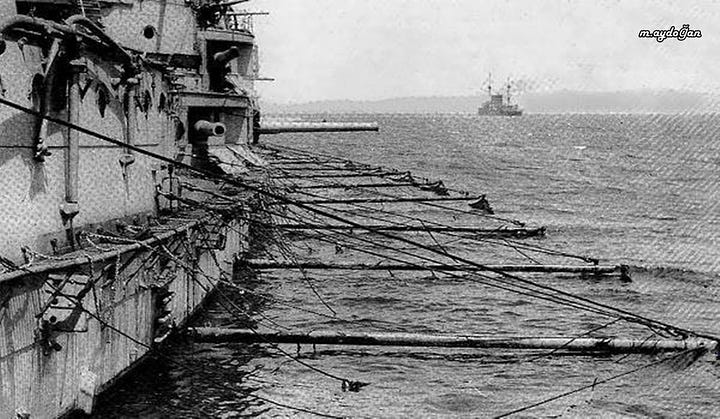
It would be the naval equivalent of the tank ‘cope cage’, now standard across the battlefield.
Lastly, Fighterbomber writes that Russia clearly has no capability to deal with this threat as of yet and so for now it’s best to retreat everything out:
It can be stated that BECs have shown their highest efficiency, and accept that at the moment large ships cannot effectively resist BECs.
Speed, night, stealth and the number of BECs participating in the attack solve issues with thermal imagers and additional fire weapons on board and in general with everything.
I don’t know what conclusions can be drawn other than the fact that now it is necessary to accept this fact, move all large ships beyond the effective range of BECs, close mooring areas with engineering means to prevent BECs from damaging ships at the berths, transfer the tasks of the Black Sea Fleet to small and high-speed boats and boats type "Raptor", submarines and aircraft.
Well, it’s natural to speed up cutting your BECs.
Along the way, around the clock testing somewhere in Vladivostok various options for defensive weapons, detection, guidance and electronic warfare equipment on existing Navy ships, endlessly simulating BEC attacks in practice.
I repeat, repeat. Today we need to simulate not attacks by submarines of a hypothetical enemy, but attacks by high-speed, small-sized targets with television guidance.
Well, for the best, all this should be done, as usual, yesterday.
Would any other navy in the world be able to deal with such a threat? Personally, I doubt it. We’ve seen recent humiliation after humiliation with the British Navy, for instance, unable to even sail its premier ships anymore. The German Navy suffered an even worse humiliation, firing two world-class SM-2 missiles accidentally at an American drone, with both missiles failing, as reported by BILD.
The U.S. Navy would likely have more and better sensors like night vision optics to at least stand a chance, but ultimately a swarm attack of the same caliber would likely take them out too.
And don’t forget who’s really directing these attacks:
So, ultimately, while plenty of criticism can be heaped on some of Russia’s efforts or oversights in this case, NATO would do no better under similar circumstances. And anyone who disagrees is free to offer up a substantive example of a parallel peer-level conflict where NATO had to solve an even remotely similar strategic dilemma as what Russia is up against.
Oh, I forgot, there was one semi-comparable case, and in that scenario the UK lost more capital ships than Russia in a fraction of the time:
—
Ultimately, while it’s true the naval losses have no real bearing on the Ukrainian conflict itself, because it in no way helps Ukraine in the fight on the ground, it does put some wind in the sails of the propaganda effort, as the recent Black Sea successes have become the only holdfast for the pro-UA side to cling to as putative ‘evidence’ of its winning posture:
A few last items:
While Ukraine has done some damage in the Black Sea, it continues to suffer grievous losses on the ground in the real fight. The first, then second, third, and potentially even fourth Abrams were destroyed:
From National Interest:
Summary: In under a week, Ukraine witnessed the destruction of three U.S.-made M1 Abrams tanks, reportedly by Russian anti-tank guided missiles. These losses, particularly highlighted on social media, have served as a propaganda boost for Russia.
But as a propaganda victory, Konashenkov even claims that it was a Russian T-72B3 that took out the latest Abrams in a legendary tank duel:
Granted, without footage I remain skeptical because this is such a low hanging fruit propaganda victory it’s almost too tempting to pass up. More likely, as the footage we do have suggests, the tanks were destroyed with ATGMs and drones—but I remain to be proven wrong if footage of a tank-on-tank kill appears.
But in an even bigger propaganda victory, the first ever fully confirmed HIMARS kill has finally been realized:
From one of the UA ‘authorities’:
In this case, the chances are high that it was a true duel, with a Russian Tornado-S “HIMARS-killer” GMLRS launcher coming out on top in a counter-battery kill on its arch-rival.
We also have startling new footage of the huge uptick in usage of the RBK-500 clusterbombs by Russia over Ukrainian positions.
They are said to devastate positions at a time when Ukraine has run low on their own DPICMS—not to mention that Russia has adapted them into the UMPK glide-bombs which now rain these deadly fragments over AFU positions daily. Here are three combined new videos:
Journalist Evgeny Poddubny:
Remember how the enemy rejoiced that Western countries, with an acute shortage of high-explosive fragmentation weapons, brought cluster munitions to the front. But the joy did not last long, as Pandora's box was opened.
The video shows the use of the RBK-500 bomb by our operational-tactical aviation against an enemy concentration in a forest belt. There are no more safe places on LBS. Even relatively. By the way, this is a group covering the state border. And the enemy’s losses continue to mount.
That’s not to mention glide-bombs being used so unsparingly as to be thrown at Ukrainian forest-belt positions and trenches, like this video shows from today:
Your support is invaluable. If you enjoyed the read, I would greatly appreciate if you subscribed to a monthly/yearly pledge to support my work, so that I may continue providing you with detailed, incisive reports like this one.
Alternatively, you can tip here: Tip Jar







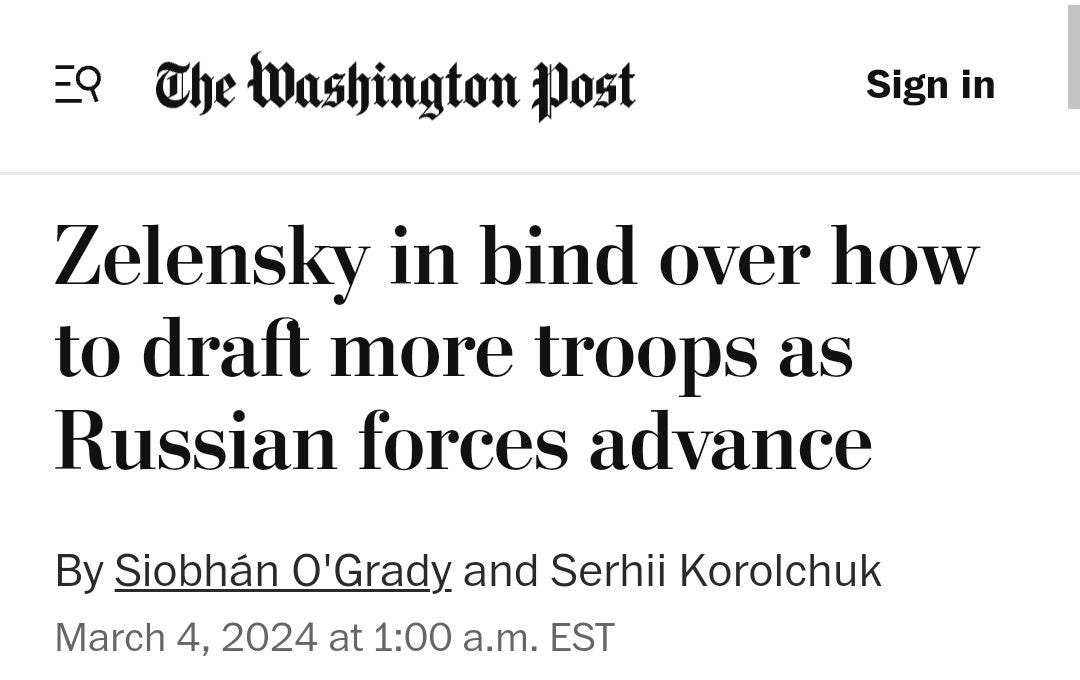
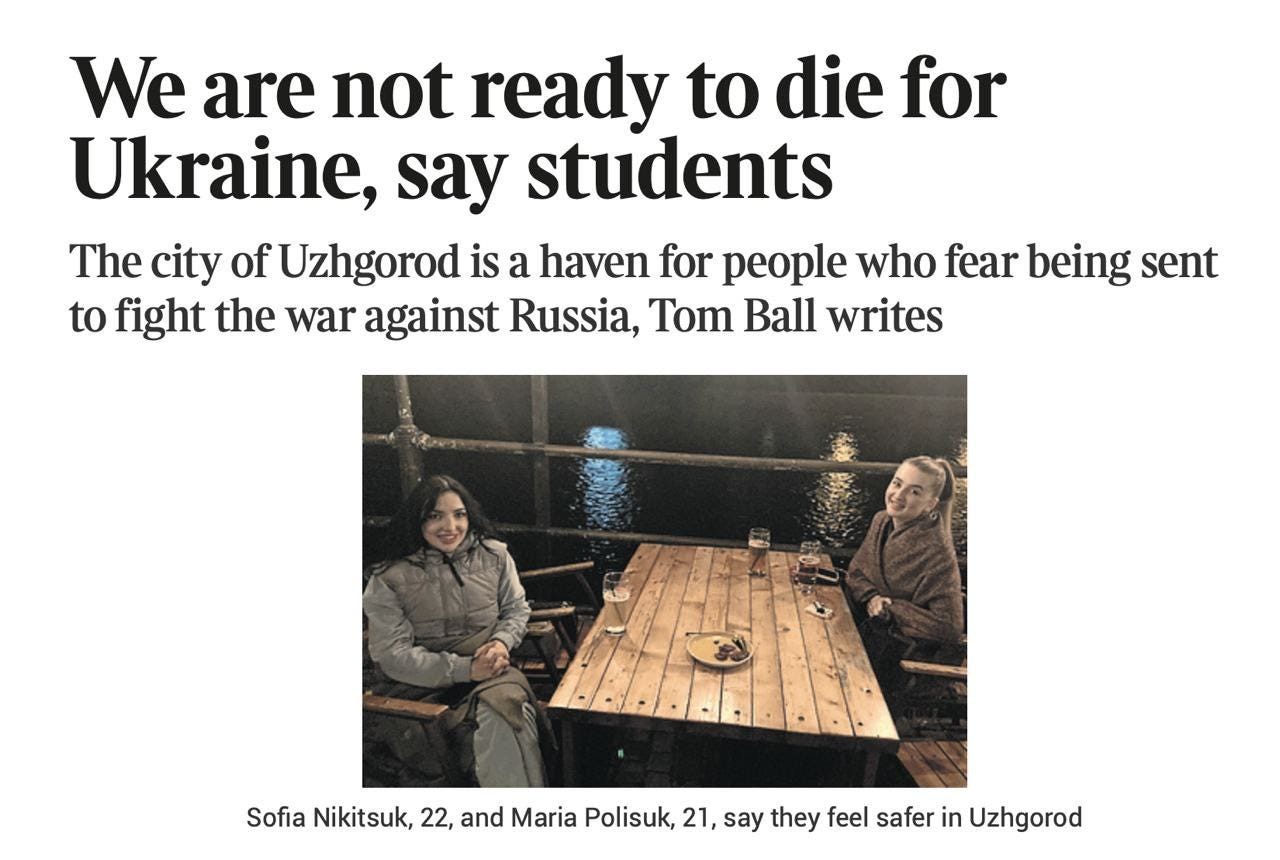




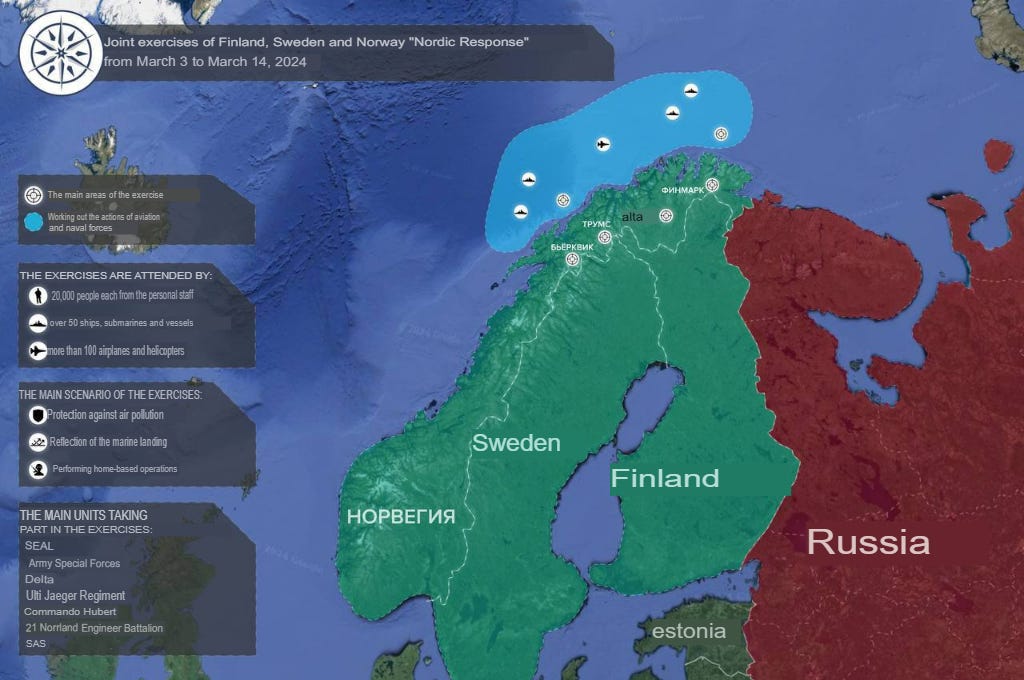


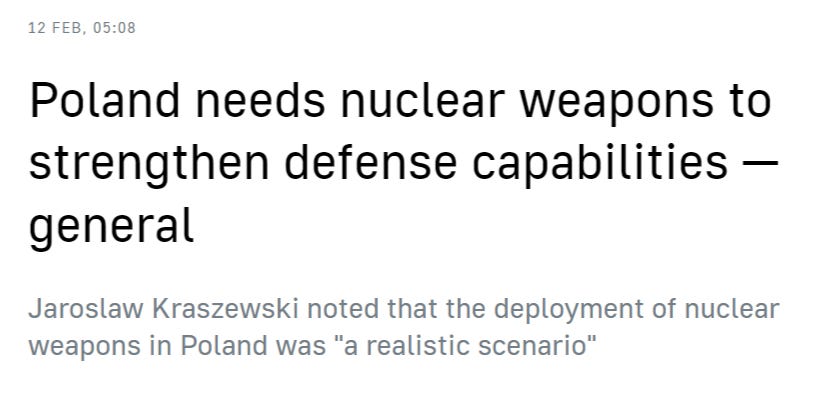





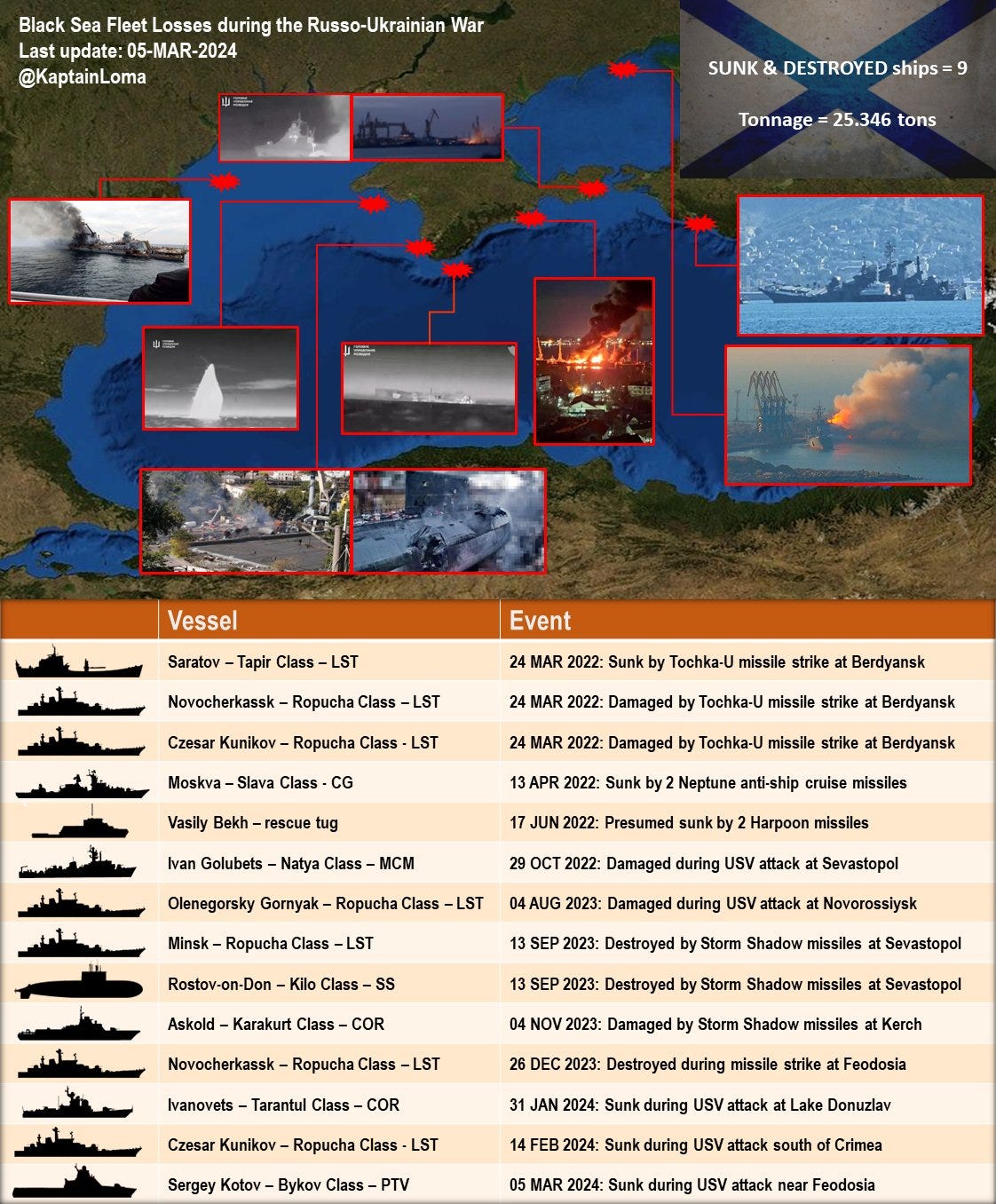









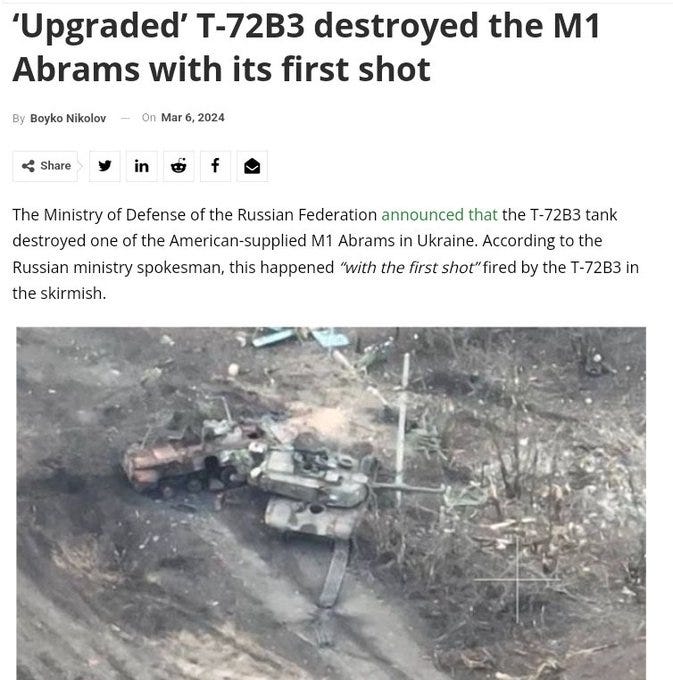
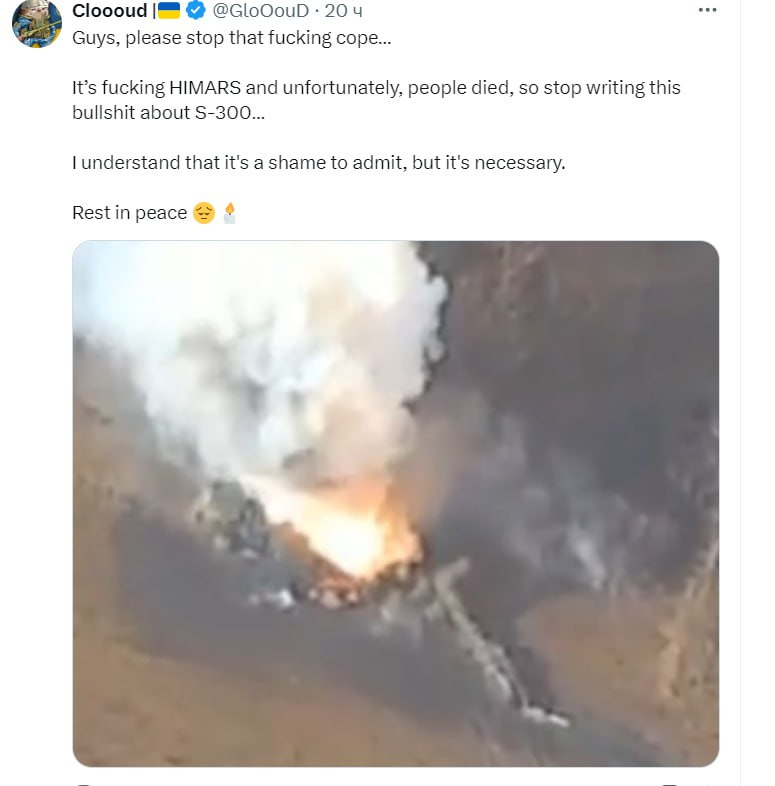
Great sitrep! Thanks for the update. However, I respectfully disagree with the discussion on Black Sea fleet losses.
First, the Black Sea naval battle is not a war between Ukraine and Russia, it is a war between NATO and Russia. The nazis in Kiev have a completely negligible role in it. All of the attacking drones are NATO made, all of the communications links are run through NATO satellites and relays, all of the surveillance of Russian targets and battle planning are done by NATO personnel using NATO equipment and NATO computation, and almost certainly the actual operation of NATO drones in their attacks against Russian ships is being done by NATO personnel sitting in NATO countries.
Napoleon once remarked, "Amateurs talk about tactics, professionals talk about logistics." Focusing on defeating the drones in the final moments of their attack is a mistake and is not the way to win the naval battle. It is a mistake analogous to thinking about defeating a US entry into a European war by focusing on having better body armor to resist US bullets, when the only way to win such a war is through logistics, preventing the US from casting large armies and munitions across oceans into the front.
The current NATO war on Russia's Black Sea Fleet is having successes because Russia is not fighting the logistics and infrastructure on which NATO's successes depend. The warships Russia has in the Black Sea were not designed for fighting limited wars where the enemy gets to shoot at them all it wants from safe harbors far away. Their armament assumes, and completely depends upon, war fighting from Russia which eliminates or reduces threats that otherwise will destroy those vessels.
Contrary to much speculation in this sitrep and in most commentary on naval drones, they are effectively indetectable by any modern technology. There are *no* ISR capabilities that can detect them. Heavy, long-endurance drones with sensitive IR options *cannot* detect them. No fighter or AWACS aircraft can detect them, not even with specialized look-down radar. Some of the early naval drones certainly used Starlink, but current models do not: they operate on direct-to-satellite links running through US/NATO military satellites which can neither be detected nor jammed. There is *no* amount of continuous, round-the-clock overflights or anything else which can detect those drones before their attack commences. Do not succumb to magical thinking like the West applies.
What *can* be detected and destroyed is the infrastructure on which those drones rely. NATO cannot direct the drones on target without NATO's AWACs aircraft. Kill those AWACs aircraft and "real time" US and NATO satellites will have a much harder time finding the ships and tracking them close enough to real time to bring drones on target.
Those real-time satellites are also few in number and hugely expensive, costing more than a mid-sized aircraft carrier, because they use geosynchronous orbits to stay over a target area. Geosynchronous orbits are very far away from the Earth's surface and require use of immensely large mirrors (the original used a spare Hubble mirror blank) to achieve desired visual resolution. Destroy those, or destroy the ground stations on which communications with the satellites depend, and you blind the US/NATO forcing them to depend on low orbit satellites that quickly overfly the target area without continuous real time coverage.
(I wouldn't be surprised if US detection of increased Russian interest in taking out satellites was the basis for recent Western hysteria about Russian nukes in orbit.)
Finally, the key to defeating NATO's strategy in attacking Russia's ships is to skew the cost balance of such attacks in Russia's favor.
The ships killed thus far in the Black Sea are completely strategically unimportant even from a naval perspective. The Sergey Kotov was an absurdly lightly armed patrol ship, having no function but to patrol with a powerful radar to monitor ship traffic and to report aviation threats to other military assets. Investment in that class of ship has been highly controversial in Russia because it has virtually no use in war.
NATO attacks using inexpensive NATO weapons operated by NATO forces only make sense as propaganda victories against such ships if NATO pays no price for such attacks. But killing minor patrol ships, no matter how modern and spiffy they are, makes no sense for NATO if NATO pays a significant price for that propaganda.
Such attacks make no sense at the cost of losing *all* of NATO's AWACs aircraft, elimination of air bases where those AWACs planes were based, destruction of the UK's bases used to operate remotely the UK's naval drones, loss of three or four of the $10 billion US real time KH satellites, or the destruction of UK factories used to produce those naval drones. Russia could also sink the UK's two new carriers with hypersonic conventional warheads just for style points, to show that "two can play that game."
Considering the above the sinking of the Sergey Kotov (it almost certainly was indeed sunk) is not so much evidence of irresponsibility, neglect, or outright incompetence in the Black Sea Fleet senior command as it is evidence of Russia *choosing* to fight with profound limitations on the force it uses even though it knows that choice will, for sure, result in sinkings.
Look at it in that light, and losing a $100 million ship is not a big deal if it allows the war to continue in such a limited way that Russia's economy can continue to expand, raking in windfalls of $600 billion and more of higher income.
Good news for Ukrainian 21 year olds. Senile Brandon opened his state of the union stumbling by saying he won’t back down from Putin. Enjoy being turned into cannon fodder for the Globohomo American Empire!